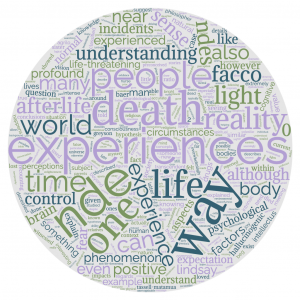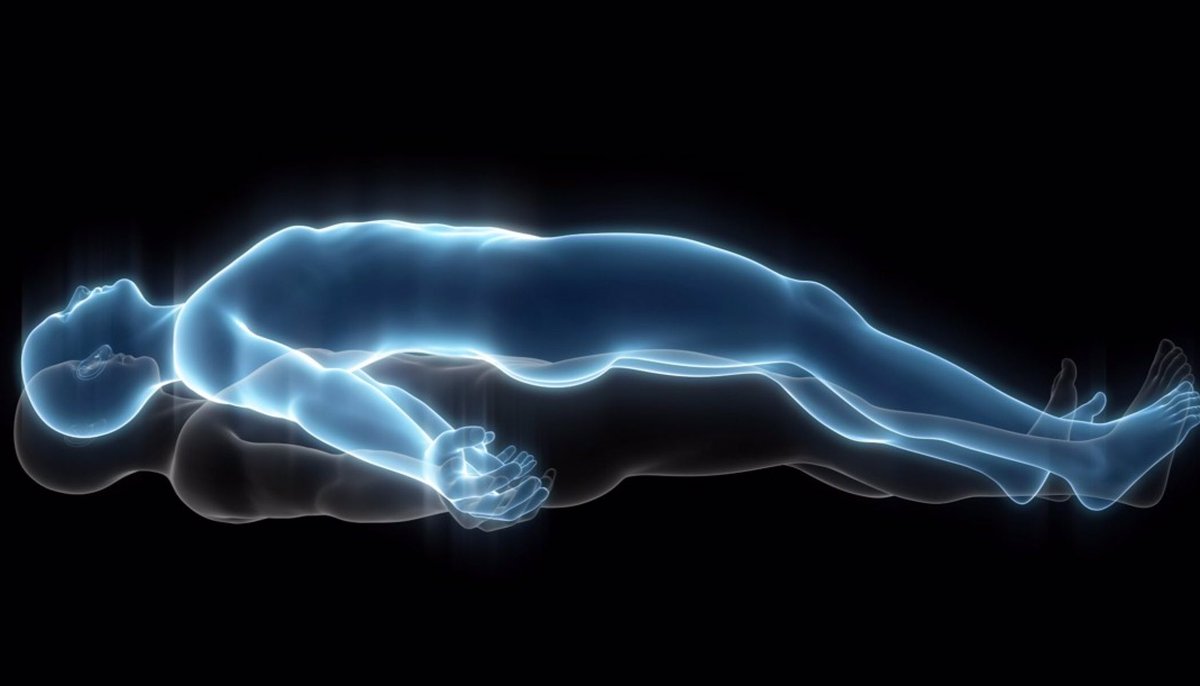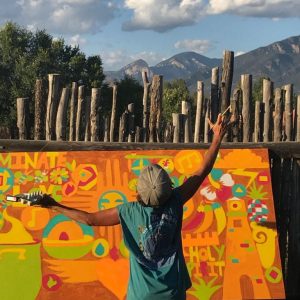39 Near Death Experiences and their Implications for the Afterlife
MJ Levin

Hi, I’m MJ. I felt drawn to the topic when we touched on it in my Religion and Environmental Values class, as the stories people recalled, with evidence supporting it, completely changed my understanding of the laws of nature and the abilities of the human consciousness. It also intrigued me to research something that included so many subjects that are arguably considered taboo to discuss in Western culture such as death, afterlife, spirituality, and the transcendent nature of the psyche…read more.
 What happens after death is a mystery that humans all over the world have speculated on since the beginning of time. In many religions, there is a sense of certainty among the followers regarding what to expect when they pass, as promised by God or a higher power they worship. Although no one really knows for sure, the closest we have come to proving the reality of the afterlife are the stories told by people who have had near death experiences, or even died temporarily and came back to life. Spiritual revelations during these incidents are a cross-cultural phenomenon felt all over the world, with details that overlap and hint at the answer to this unsolved mystery.
What happens after death is a mystery that humans all over the world have speculated on since the beginning of time. In many religions, there is a sense of certainty among the followers regarding what to expect when they pass, as promised by God or a higher power they worship. Although no one really knows for sure, the closest we have come to proving the reality of the afterlife are the stories told by people who have had near death experiences, or even died temporarily and came back to life. Spiritual revelations during these incidents are a cross-cultural phenomenon felt all over the world, with details that overlap and hint at the answer to this unsolved mystery.
Near death experiences, or NDEs, are a profound and divine phenomenon in which someone, typically in a life threatening context, transcends the normal human experience as we understand it into another realm with heightened cognitive capacity and different laws of nature. The most common characteristics that describe NDEs include a sense of peacefulness and acceptance; seeing a bright, unfamiliar light; meeting religious figures or late loved ones; transcending space and time; and leaving your body, with the ability to see yourself from the outside. Other common reports describe moving through a tunnel towards the light, entering a new domain and reviewing one’s life. These incidents are oftentimes described in an overwhelmingly positive manner, yielding beneficial results; however, our society generally disregards them as false perceptions with little value that can be explained away by psychological or neurobiological factors (Facco et al., 2012).
One of the most common psychological explanations for NDEs is the expectation hypothesis. When someone is in a life-threatening situation, it oftentimes induces an altered mind state in which they are desperately trying to make sense of the situation at hand. The expectation hypothesis suggests that NDE is a product of this, and when someone is in this state of mind, they subconsciously project their preconceived notions of the afterlife onto the experience they are having. Critics of this theory point out that it is unrealistic to claim that people can develop these complex scenarios in such a short amount of time during an intense, life-threatening situation (Facco et al., 2012). Additionally, NDEs cannot be explained away by physiological factors alone as many people in similar circumstances do not go through this experience. For example, there was a study in which only 12% of cardiac arrest victims experienced NDE, despite all being in a near-death situation (Lindsay et al., 2020). Other psychological explanations include reliving the memory of birth in which one travels through a dark tunnel towards a bright light into an unfamiliar realm; or channeling false memories to fill in the gaps of the unconscious experience after reawakening.
The reality of these incidents has also been challenged by the neurobiological hypothesis which states that NDE is simply a side effect of brain disorders. People who are treated for these disorders are typically given intense doses of medical drugs, which could be responsible for the seemingly unreal nature of the experience. This is especially true with hallucinogenic drugs, which are known to induce out of body experiences and transcendence into other realms. However, not everyone who has a NDE is neurodivergent, so this theory is not supported by strong evidence (Facco et al., 2012).
Another interesting aspect of the phenomenon is that it can also happen to people who are not in life-threatening circumstances. Although rare in occurrence, many people have experienced it this way, disproving the expectation hypothesis which implies that NDE happens when people are subconsciously preparing for death. One case which exemplifies this event was studied by psychologists Enrico Facco and Christian Agrilo. The subject who experienced NDE was a non-religious, neurotypical man in a non-life-threatening context, three factors which contradict the expectation and neurobiological hypotheses. He was vacationing in the mountains with his young daughter, when one night he had a NDE, seemingly without cause. A massive, great white light appeared in front of him which looked unnatural, yet not artificial in the sense that he was familiar with, followed by several smaller ball-shaped lights. The light poured through his body, which he recalled felt like a stream of overwhelming love and joy. There was an intense feeling of oneness between himself and all things in the universe– all quintessential elements of NDE.

The aftermath of this experience was profound for the subject. A deep paradigm shift had occurred in the way that he understood life and death, no longer perceiving the latter in a negative light nor something to be afraid of. Alternatively, he felt that it was something to embrace simply as an inevitable part of life that is intrinsic and inseparable to the human experience, recounting it as an indescribable divine beyond the conventional concepts that exist in our society (Facco et al., 2012). It is interesting that as he lost control of his reality, his fear of death–which is intrinsic to all human beings–was released as well. This relationship between control and fear of death is fleshed out in the article, “Our Need to Control: Implications for Environmental Education” by Richard Baer in which he describes the human need for control as the deep-rooted cause of many evils including environmental destruction. Within this topic, Baer argues that the concept of death is the biggest fear that lies in the hearts of all humans as it is the one thing that is ultimately out of our control (Baer, 475). When the subject lost control of his outward reality along with his mind and body, he was able to free himself of this innate and oppressive fear, even after the experience had ended.
He also felt a rejection of the restricting institutions of logic and reason that shape the way in which our society understands reality because his experience simply could not be explained through these terms. As a way to symbolize this newfound departing from the importance of this way of knowing, the subject recorded his experience immediately afterwards in the form of a poem instead of the traditional way of writing out a grammatically-correct and rule-abiding report.
Despite the fact that the incident occurred in circumstances that were far from life-threatening, it is still classified as a NDE due to the degree of similarity that it has to other accounts. More specifically, it was shaped by the following factors which are essential to the phenomenon: vision of supernatural light, complete loss of sense of time, peacefulness, deep joy, empathetic fusion with the entire world, clear perception of a reality beyond the ordinary world, understanding everything about the universe, and encounter with entities. Factors that explain NDE in normal circumstances like this one include serious conditions, depression, isolation, existential crisis and meditation. The only significant element present during this case that could have induced it was the fact that he was going through a divorce at the time. This could be classified as “role transition” in which intense self-reflection can lead to unusual brain activity. However, there is little evidence to suggest that this factor alone could be responsible for such a profound experience, given the frequency of role transition in many people’s lives and the lack of its correlation to the occurrence of NDEs (Facco et al., 2012).
Near death experiences like these, in which people see an overwhelmingly bright and unnatural white light, have tunnel vision, leave their bodies, meet religious figures or dead relatives, transcend space and time, and feel extremely positive emotions, beg the question: what does this tell us about the afterlife? In a study done by psychologists Nicole M. Lindsay and Natasha A. Tassell-Matamua, over a hundred subjects were surveyed regarding their belief (or disbelief) in the self after death. About half of them had gone through near-death experiences, while the other half had not. The results showed that people who had a NDE were much more likely to believe in a form of afterlife, particularly the aspects of continued consciousness and the existence of individual self beyond their lifetimes (Lindsay & Tassell-Matamua, 2021).
Not only do these reported experiences change our understanding of the afterlife, but they also make us question what is possible in our own reality. Many of the characteristics of near death experiences previously mentioned defy our preconceived notion of what can be experienced during life on earth. Psychiatric and neurobehavioral expert and professor, Dr. Bruce Greyson describes several examples of reality-bending NDEs that shatter our current understanding of the complex human experience. One shocking discovery is that people have actually left their bodies, gone to other locations and witnessed real events that actually happened. In fact, a recent study was done in which over 100 people were surveyed on their out of body experiences during NDE and 90% were completely accurate in recounting what they had witnessed out of their bodies in a different location (Khanna et al., 2014.)

Even more shocking, people have reported seeing dead relatives in the afterlife whom they were not yet aware had passed. For example, a nine-year-old boy who was hospitalized for meningitis encountered a number of late family members, including his older sister who told him to return to life on earth. As far as he knew, his sister was still alive up until this moment; but when he woke up and told his parents what he saw, they contacted her college and found out she had just died in a car accident a few hours before (Greyson, 2018).
There have also been incidents in which people have conversations with real life peers, receiving accurate information during NDE which they would have no way of knowing otherwise. For example, one man who had been in the hospital for awhile had the same nurse every day. One day, his health began to deteriorate and he had a NDE in which his nurse asked him to deliver a message to her parents: that she was sorry for crashing their red sports car. When the experience ended and he returned to normal life, the patient told his nurse about their conversation and she immediately started tearing up. Her parents had, in fact, gifted her a red sports car for her birthday which she totaled the first time driving it (Greyson, 2018).
In some cases of NDE, people even meet someone they do not know at the present time, but will know later in life or are somehow tied to unknowingly. A man in Holland who suffered from a cardiac arrest transcended from his body and afterwards reported seeing his late grandmother along with a man he did not recognize. Since this man was unrecognizable, he kept the incident to himself and gave it little thought until one day, when his mother was on her death bed, she confessed that the man who had raised him was not actually his biological father. Instead, his real father was a Jewish man who had been killed by the Nazis in a concentration camp. When she showed him a picture of this man, he immediately recognized him as the one he had met 10 years prior during his NDE. There is absolutely no way to explain these incidents with logic and reason in the way that we currently understand our reality (Greyson, 2018).
This defies our concepts of space, time, and the capabilities of our consciousness. During near death experiences, we reach heightened mental thoughts as the brain functions differently than normal. We have accurate perceptions through out of body experiences, reunite with loved ones who we may not have even known were deceased, and meet deceased ones that we may not have even known were meaningful to us. This leads us to believe that there is something within us that lives on after our bodies shut down. As this topic has only recently begun to be researched seriously in science and psychology, we are still mystified by this phenomenon and are only left with real life experiences, like the stories aforementioned, from which to draw conclusions. It is clear that a transient disassociation between our bodies and minds is possible and that we have abilities far beyond our previous conception as a global society. These experiences also beg the question of immortality in regards to the consciousness as we are apparently able to exist in some form after death, although for what amount of time and to what extent is unknown.
One of the biggest conclusions from understanding these new reports and studies is that it is time to reassess the way in which we understand the world around us. Seeing as though none of the current hypotheses provided by scientists and psychological experts sufficiently explain the mystery of NDEs, the way it is studied should be improved. As of right now, we are only using the ‘ratio’ way of understanding information when we should be using “intellectus” as well. Baer describes these two ways of knowing in his article by stating that ratio is the “power of discursive, logical thought, of searching and examination, of abstraction, of definition and drawing conclusion,” originally defined by philosopher Josef Pieper. As the primary method of understanding reality in Western society, ratio is opposed by intellectus, an intuition-based way of knowing that allows passive reception of knowledge through contemplation and at times, spiritual experiences (Baer, 490) like the ones described in this paper.
Our society’s negative perception of transcendent experiences is harmful and counterproductive. If they were validated, we would be able to grasp their benefits more fully and further develop our sense of reality as a species. In the case studied by Facco and Agrilo, the experience beared positive cognitive and emotional results as the subject was released from his fear of death and revolutionized the way he experienced life. For something that had such a profound and positive impact on a person’s life, it feels almost criminal to reduce its significance to a “neurological or psychiatric impairment” (Facco et al., 2012). Interestingly, although he had no background in philosophy or Eastern religions, the subject’s poetic recount detailing the experience aligned impressively close to the path of enlightenment as described in Buddhism and other Eastern religions. According to philosopher David R. Loy, Buddhist teachings offer the idea that the sense of self as separate from other entities is delusive and harmful to the way in which we perceive ourselves and our relationship to the universe. By following the path of enlightenment, we can unself and become one with the natural world, releasing ourselves from the pressures and anxieties of living in the mental construct as an individual (Loy, 2010).

The subject’s experience and other similar cases are also very similar to the effects of hallucinogens in their transcendent, empathogenic and entheogenic aspects. Given the positive impacts associated with NDE, and its similarities to hallucinogenic experiences, the authors suggest that we reconsider the way in which we view these substances, especially given their historical uses linked to spirituality and religion. One example of this is the use of iboga, a natural hallucinogen, in the Bwiti religion where it is used during a complex ritualistic coming of age ceremony in which NDE is purposely simulated. Each person who lives in this community goes through this experience, leading to profound and enlightening impacts so that they can share a similar and in-depth perspective of the world around them. Other natural hallucinogenic and psychoactive substances such as psilocybin mushrooms and peyote have been used for centuries by indigenous peoples and spiritual shamans to connect more deeply to nature, alter problematic and stagnant mindstates, and create new thought patterns. This is able to happen because these drugs actually diversify the paths that the user’s brain follows–something that is extremely difficult to accomplish otherwise (Lindsay, 2021).
The societal context also informs the way in which these experiences are perceived. In many ancient cultures, transcendent experiences or visions alike were normalized and appreciated, helping to inform the way in which people understood the world around them. This is in stark contrast to today’s societies, particularly in the Western world, in which they are disregarded as false perceptions explained by dysfunctions of the brain and allotted little if any value. This goes back to the concepts of ratio versus intellectus knowledge and exemplifies how we value the latter significantly above the former. Although NDEs can vary within their context, the core aspects remain consistent cross-culturally (Lindsay, 2021).
Given the fact that near death experiences occur all over the world with similar details and groundbreaking implications, it is time that we utilize all ways of knowing so that we can reach a deeper understanding of the world around us and what it means to be alive and to die. Some elements such as seeing the white light, meeting pious figures, reconnecting with dead relatives, and feeling overwhelmingly positive emotions are reminiscent of religious descriptions of the afterlife. This is especially true when looking at the way in which “heaven” is described in the Bible. However, many aspects of NDE are new to the preconceived ideas that we have of this place, and it leads us to wonder what else we are missing. The diverse and astonishing experiences through NDE completely shift the way in which we understand our cognitive abilities, the transcendent nature of our consciousness, and the relationship between life and death in regards to the physical and non-physical reality. Although significant questions remain in the air, the stories of these near death experiences greatly inform the truth behind the afterlife, and we may be closer to the answer than ever seemed possible.
References
Baer, Richard A. “Our Need to Control: Implications for Environmental Education.” The American Biology Teacher.
Facco, Enrico and Christian Agrilo. “Near Death-Like Experiences Without Life-Threatening Conditions or Brain Disorders: a Hypothesis from a Case Report.” Frontiers in Psychology. 15 November, 2012. https://www.frontiersin .org/articles/10.3389/fpsyg.2012.00490/full.
Khanna, Surbhi and Bruce Greyson. “Daily Spiritual Experiences Before and After
Near-Death Experiences.” Psychology of Religion and Spirituality. 2014.
https://www.apa.org/pubs/journals/features/rel-a0037258.pdf.
Lindsay, Nicole M. and Natasha A. Tassel-Matamua. Near Death Experiences and After
Life Belief: a Mixed-Method Analysis. Psychology of Religion and Spirituality, Vol
13(3). August, 2021. https://psycnet.apa.org/buy/2020-02079-001.
Loy, David R. “Healing Ecology.” Journal of Buddhist Ethics, vol. 17. 2010.
Is There Life After Death? Moderated by John Cleese – 2018 Tom Tom Festival. Tom Tom Foundation. 30 May, 2018. https://www.youtube.com/watch?v=4RGizqs Lumo.

